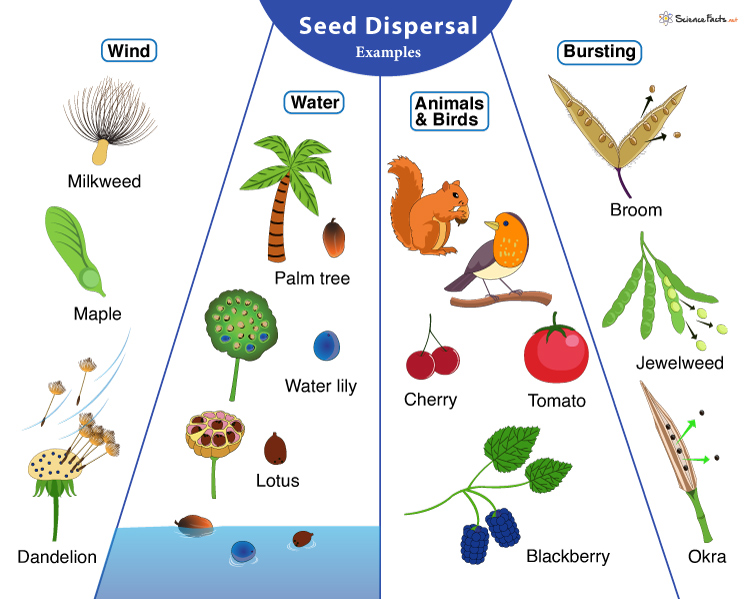Before they can develop into a new plant, seeds need to leave the seed pod. If all the seeds land underneath the parent plant, they might not get enough sunlight, water, and nutrients to germinate. Since plants do not perform the physical movement to take their seeds to another place, there are ways to transport them.
What is Seed Dispersal
How are Seeds Dispersed: Types and Examples
What is the Importance of Seed Dispersal
- Wind: Seeds of plants such as maple, milkweed, dandelion, swan plants, and cottonweed trees are light and feathery, which helps them carry to a distant place by the wind. In contrast, some plants like maple have winged seeds that do not float but flutter to the ground. Seed dispersal by wind has the advantage that it allows seeds to be transported far away from the parent plant, thus reducing their growth competing. On the other hand, the primary constraint on wind dispersal is the need for abundant seed production to increase germination as much seed gets wasted using transfer. All seeds cannot be dispersed by wind. They need to be lightweight and have wings so that wind can carry them off.
- Water: Many aquatic plants such as lotus, water lily, and palm trees are waterproof and float on water to be carried to a distant place. The seeds of such plants float on water for a while and then drop down to the bottom to form roots on the pond’s floor. On the other hand, seeds of terrestrial plants like mangroves germinate when ripened seeds fall from the tree touching the ground. During low tide, they might fall in soil instead of water from where they start to germinate. However, if the water level is high enough, they are carried far away from where they fall.
- Animals and Birds: Few animals and birds are attracted to bright, colorful fruits like blackberry, cherry, and tomato. They eat the whole fruit but digest only the juicy part, excreting the seed, which forms new plants. Maple seeds being tasty, animals store them without eating them all. The uneaten seeds germinate some distance from the parent plant. Some squirrel species collect nuts from plants like acorns and bury them under the soil to store food for the winter, often forgetting the burial place. The seeds then grow into a new plant. Seeds of plants like burdock produce seeds with hooks that stick to animal bodies. They are then carried to a distant place where they grow into a new plant once they reach the soil. Sunflower, date, sea grapes, tamarind, raspberry, legume (bean), and avocado are typical examples of plants whose seeds are dispersed by animals and birds. Humans also take part in the process of seed dispersal. Sticky seeds attach to the human body and their shoes and boots while walking in the forest. When they move a long distance, seeds often get transported miles away from their origin.
- Bursting: Ripened fruits burst open to release seeds into the external environment, a process known as the explosion of seeds. This type of seed dispersal, also known as ballistic or mechanical dispersal, is mainly seen in plants with pods such as jewelweed, okra, lupins, gorse, and broom. The pods dry out once the seeds are ripe. When dry, the pods split open to scatter seeds. Apart from the above four ways, seeds of plants also spread commonly through means of gravity and fire. They are described below: Gravity: Fruits fall off from plants to reach the ground due to the force of gravity, get buried in the soil within a few days, and eventually germinate into a new plant. Fruits of some seeds have a soft seed coat, which breaks open once they fall, causing dispersion of seeds. In some other cases, fruits with seeds are carried to a distant place by other agents like wind, water, birds, and animals for dispersion. Apples, coconuts, passion fruit, canna, and calabash are typical fruits whose seeds are dispersed by gravity. Fire: Some pine tree species require the heat from a fire to allow their cones to open and disperse seeds. Banksias and eucalypts also rely on fire for their seeds to disperse. The fire’s intensity and timing are essential that allow the cones to open out. However, if fires are too frequent, there is not enough time for the plants to grow and make new seeds.
Increasing the chance of survival in plants: Seed dispersal prevents overcrowding of plants in an area, thus increases their chance of survival.Reducing competition for growth: Seed dispersal helps seeds to be deposited away from the parent plant. It reduces competition for nutrients, water, and sunlight required for their growth and increases their survival chance.Reducing plant disease spread: A disease or infection in a particular plant species spreads very fast. Suppose plants of the same species grow far away from each other due to seed dispersal. In that case, the chance of spreading the infection can be significantly reduced.
Increasing distribution of habitat: Seed dispersal allows plants of the same species to grow in new places. It provides them with wider geographical distribution and better growth prospects.Helping in plant conservation: At a time when plant species experience environmental challenges such as weather and climate change, attack from invasive insects and animals, and land use, dispersal helps plants of the same species to survive in distant places, ensuring conservation of the plant species.
